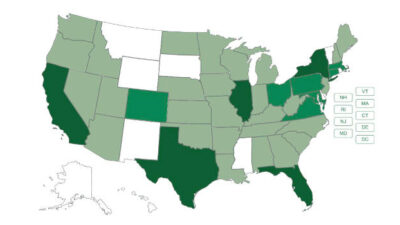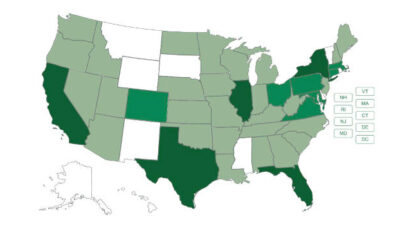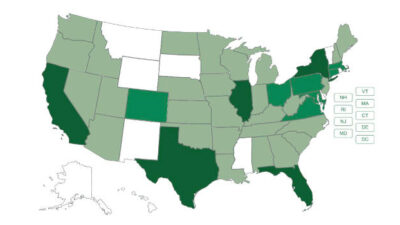Morrissey Goodale takes a look back to last November and the 21 predictions they made for 2021.

Morrissey Goodale takes a look back to last November and the 21 predictions they made for 2021. These fall into the following four categories:
(Nailed It! Or as Larry David would say, “Pretty, pretty good.”) These are the predictions where Morrissey Goodale either stuck the landing or would have done well with hand grenades or horseshoes (we were close). Like the parents of a first-grade soccer player who just won a “participation” trophy, they proudly recognize our teammates who made these predictions and honor them as the “oracles” that they are who clearly have special powers.
(Jury Is Still Out) There’s definitely a trend afoot that these predictions captured—but the pattern is still murky, and the prediction didn’t 100% play out in 2021. Morrissey Goodale notes the “forecasters” on their team who got these directionally correct(ish).
(Egg on Face or Dubious at Best) Morrissey Goodale owns up and admits to where they obviously hadn’t a clue and immediately descend into some vicious internal vendetta-driven finger-pointing to lay blame at the feet of those “charlatans” who made those (now clearly ridiculous) claims.
(Mishegoss) Morrissey Goodale scratches their collective heads at the bizarre forecasts some of their “free thinkers” came up with last year and wonder what on earth they were talking about (or consuming at the time).
So, let’s take a look at how they did… (these are the verbatim predictions they made last year):
- Uncle Sam to the rescue. (Nailed It!): A Democratic administration will promote stimulus for small businesses and state and local governments that will include an infrastructure bill with a heavy focus on renewables and technology infrastructure (smart roads, charging stations, grid infrastructure, etc.). As this is a positive for our industry, we will still see significant consolidation as larger firms use this as a lever to capture market share. (Oracle: Brendon Cussio, Denver)
- Demographic shifts to lower-density settings. (Jury Is Still Out): High-density new urbanism will increasingly lose its luster, and social distancing becomes a permanent way of life. The many-year trend of the 21st century of people, especially young professionals, moving to dense urban cores will reverse as technology and investments therein enable people to relocate to more spacious, lower-cost environments away from the urbanized coasts. (Forecaster: Nick Belitz, Denver)
- Reimagined commercial space. (Nailed It!): Forward-thinking architects and developers will develop and push ways to re-position millions of square feet of commercial office space now left unused, leaving architects who are waiting for a return to the good old pre-pandemic days in the dust. Instead of JCPenney being a mall anchor store, it will be a Tesla showroom (I STILL love my 2016 Model S!) or an Apple store. (Oracles: Belitz—with Mick Morrissey, Boston, on the Tesla endorsement)
- Big boom in retrofitting and conversion. (Nailed It!): Now that firms have seen the savings of employees working from home and relatively stable productivity, urban offices will be reimagined and repurposed. There will be a real estate shift that will provide a boom to the A/E industry in the form of retrofits/conversions of these spaces. (Oracle: Cussio)
- At least a third of the industry will still be working from home by the end of 2021. (Nailed It!): Even with vaccines in play, this train has left the station. Employees love the flexibility. Firms are benefitting from reduced office-related expenses. Clients really don’t care where you work from so long as you get the job done safely and keep their data safe. Technology makes it all work smoothly. There’s no going back. And many employees know someone in high-risk categories. (Oracles: Belitz/Mark Goodale, Boston)
- You’ll tear up your employee manual. (Nailed It!): A/E firms will revisit their work-from-home policies and offer more flexibility as they now have the technology, processes, and confidence in place that this can work. Employees will expect to have more flexibility in their work environment, splitting their time between working on laptops, or on calls at Starbucks, or as they walk the dog (try it by the ocean—it’s productive AND therapeutic), or—perish the thought—in the office. (Oracle: Lisa Elster, Boston)
- Relocate? No big deal! (Jury Is Still Out): Firms will be more flexible on location requirements. By allowing more people to work remotely, relocation will not be required as much, which will make it easier to hire in many cases. The trend toward hiring people virtually will continue. In-person interviews will become a thing of the past. (Forecaster: Executive Search Team, Boston)
- Cut up your Platinum Amex business card. (Egg on Face): You won’t be travelling anywhere soon. Firms have realized they can get a bunch of stuff done in Virtual Reality and on Zoom and Teams without wasting a lot of time travelling and spending a ton of money on $15 salads at a Marriott. In-person conferences won’t be back until 2022 (that’s why all of our 2021 events will be in game-changing Virtual Reality). (Charlatan: Morrissey)
- Brain drain. (Nailed It!): The Great Recession, and now this. Many boomers will not want to stick around for the next act and will call it a career. The pressure will be on industry firms to transition institutional and industry knowledge before it’s lost for good. (Oracle: Goodale)
- Strategy shifts. (Jury Is Still Out): With people home more than ever, A/E firms will shift their strategic focus away from major metros and reallocate their growth investments towards the long-term prospects of second-tier markets, also known as 18-hour cities—such as Denver, Austin, and Nashville, amongst others. These cities provide affordable living, strong job growth potential, and growing economies and will draw investors, designers, builders, and top industry talent in the coming years. (Forecaster: Jon Escobar, Chicago)
- There will be record industry consolidation. (Pretty, pretty good): We anticipate approximately 380 deals in the U.S. next year, driven by a continued inflow of baby boomer owners selling out to private equity capital and strategic buyers that are expanding into Texas, the Southeast, and the West. (Oracles: M&A Advisory Team)
- Private equity will account for 4 in 10 transactions. (Pretty, pretty good): The great recapitalization of the industry will accelerate next year with about 40% of all deals being completed using capital from private equity or family offices. (Oracle: Nate Wentworth, Boston)
- Twenty of the industry’s top A/E firms will sell or recapitalize. (Pretty, pretty good): Typically, about 10 firms in the ENR Top 500 sell or recapitalize in any given year. Next year, that number will double. At least one publicly traded firm will be taken private next year. (Oracles: M&A Advisory Team)
- Acquisitions of tech and software firms will increase. (Nailed It!): Design and environmental firms will acquire more tech and software firms next year to try to escape a horrendous downward spiral of commoditization AND move from a business model selling time for money to a model that generates recurring earnings through technology. Less than 50% of these acquisitions will be successful. (Oracle: Morrissey (surprisingly))
- Firm values in Texas and the Southeast will rise disproportionately. (Nailed it!): Their economies will rebound faster from the pandemic, and population migration to those states will accelerate. Strategic buyers—particularly those in the Northeast and Midwest—will be even more incentivized to buy their way into these markets. (Oracle: Morrissey)
- The rise of a new breed of tech-savvy CEOs. (Mishegoss): Every CEO who barely paid attention to what was actually in the IT/telecommunications budget approved before the pandemic will finally—and joyfully—understand what the firm was paying for. They will also wonder why they are spending so much on cybersecurity—see the next point. (Free thinker: Belitz)
- The rise of the robots. (Dubious at Best): A select group of trailblazing organizations will acquire and leverage advanced technology, such as AI and AR, to create a new class of industry firms that focuses on delivering world-changing innovation vs. traditional A/E design services. (Charlatans: Goodale/Wentworth)
- The incredibly shrinking importance of the employee. (Egg on Face): Between relentless investments in technologies and massive infusions of capital, the balance of power between labor and capital will shift from employees to capital. And since our industry does not unionize (except for specific professionals in specific states), the influence that talent has on our industry will begin to decline. (Charlatan: Morrissey)
- You’ll be happy you bought cybersecurity insurance. (Nailed It!): More and more A/E firms and their clients are the victims of cyber-attacks. The data is cloudy on this as many management teams are ill-equipped with respect to how to communicate on the topic. However, by our estimation the attacks this year on design and environmental firms and their clients numbered in the hundreds. The frequency of these attacks will only increase in 2021. (Oracle: Morrissey)
- The rise of the circular economy. (Jury Is Still Out): The A/E industry will have the opportunity to lead the circular economy. The circular economy is a systemic approach to economic development designed to benefit industry, society, and the environment—vs. the linear model of “take–make–waste.” A massive portion of energy is associated with constructing infrastructure and buildings and operating them for long lives. Progressive A/E firms will have a wide-open opportunity to innovate and make great change in this area. (Forecaster: Goodale)
- Industry adoption of Virtual Reality will move quickly in 2021. (Jury Is Still Out): Particularly by firms that understand how it can be used to get closer to customers and shut out the competition. (Forecaster: Morrissey)
This article originally appeared on Morrissey Goodale’s website. Morrissey Goodale is a CFE Media content partner.



